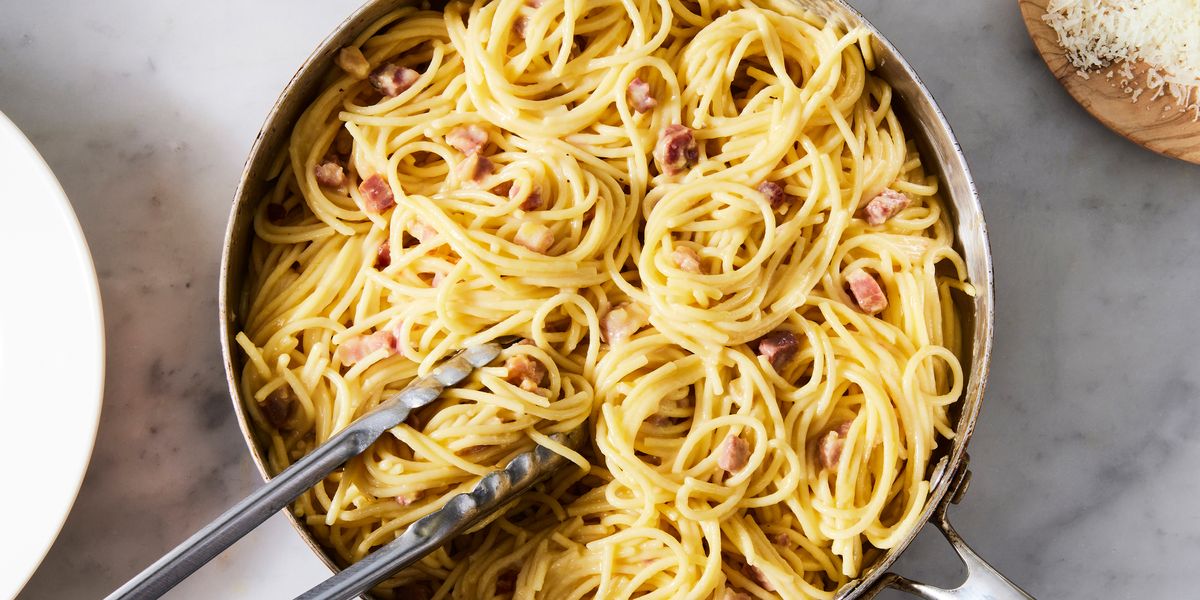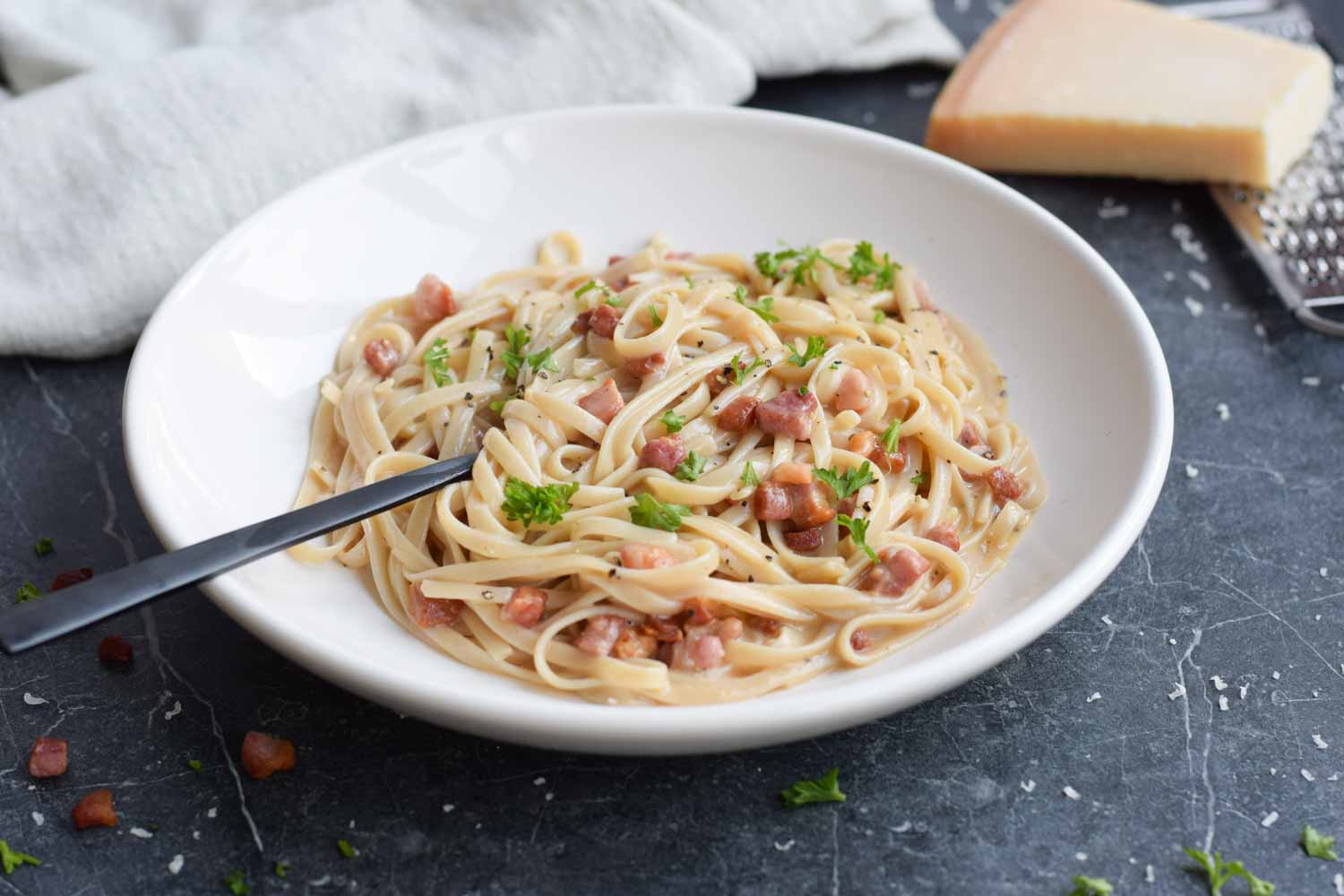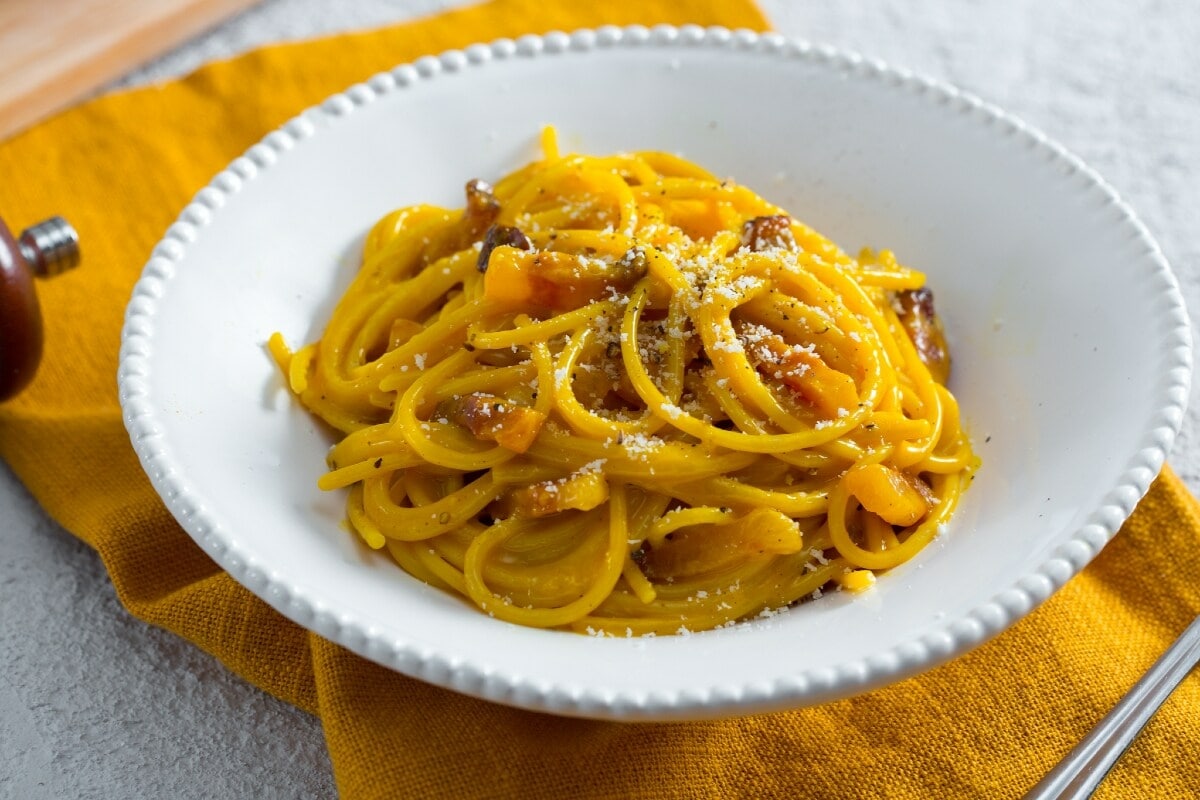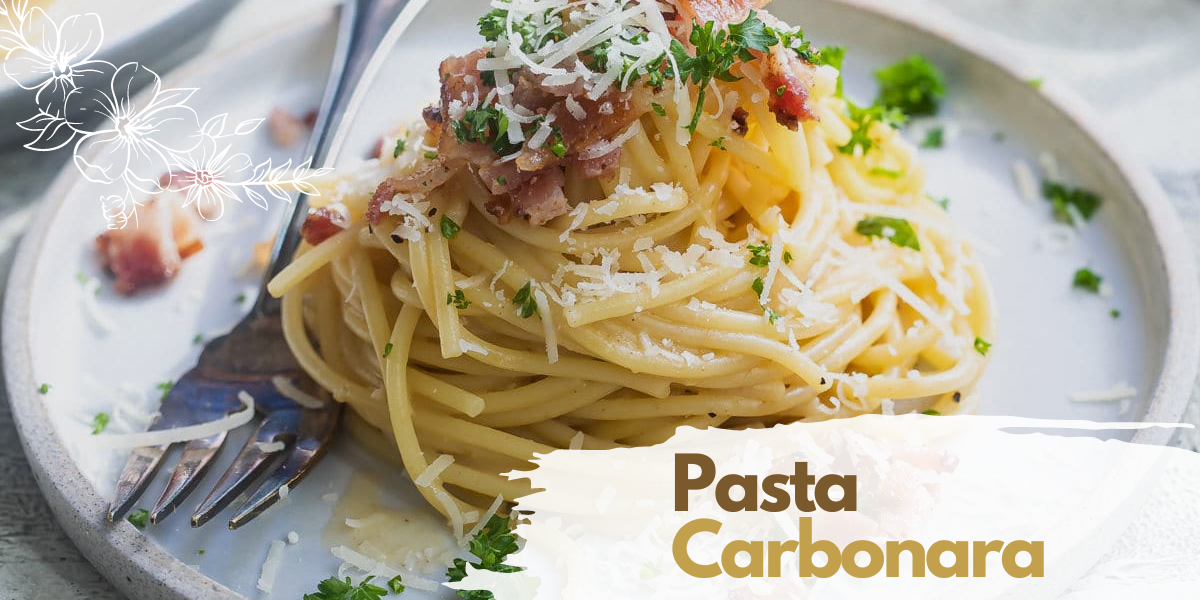The elegance and complexity of the Italian classic pasta carbonara have earned it a place in culinary legend. Pasta, eggs, cheese, and pancetta are the few components needed to make this recipe, but the results are always impressive. Come celebrate the humble beginnings and everlasting appeal of Simple Pasta Carbonara with us as we dive into the skill of making it.
Origins of Pasta Carbonara:
Pasta Carbonara has various hypotheses about its creation, but no one knows for sure where it came from. Charcoal workers in Italy (carbonai) may have been the first to make this filling dish using common ingredients like eggs, cheese, and pancetta. Some think the idea came from American troops who, while in Italy during WWII, gave Italian chefs bacon and eggs. No matter where it came from, Pasta Carbonara is now an iconic dish in Italian cooking.
:max_bytes(150000):strip_icc()/MSL-341240-Quick-Carbonara-hero-3x2-6889-8c65cdf67f1149189b492c4def3c02e5.jpeg)
Essential Ingredients:
The beauty of Simple Pasta Carbonara lies in its minimalistic approach to ingredients. Here’s what you’ll need:
- Pasta: Spaghetti or bucatini are traditional choices, but any long, sturdy pasta will work.
- Eggs: Fresh, high-quality eggs are essential for creating a creamy sauce.
- Cheese: Pecorino Romano or Parmesan cheese adds salty richness to the dish.
- Pancetta or Guanciale: These cured meats provide a flavorful base for the sauce.
- Garlic: A hint of garlic enhances the overall flavor profile of the dish.
- Black Pepper: Freshly ground black pepper adds a subtle kick and enhances the savory notes of the sauce.

Crafting the Perfect Sauce:
The key to mastering Simple Pasta Carbonara lies in creating a silky, creamy sauce without the use of cream. Here’s how it’s done:
- Cook the pasta: Bring a large pot of salted water to a boil and cook the pasta until al dente.
- Cook the pancetta: In a skillet, cook the pancetta until crisp and golden brown. Add minced garlic and cook until fragrant.
- Combine the eggs and cheese: In a bowl, whisk together eggs, grated cheese, and a generous amount of black pepper.
- Toss everything together: Once the pasta is cooked, drain it and immediately add it to the skillet with the pancetta. Pour the egg and cheese mixture over the hot pasta, tossing quickly to coat each strand in the creamy sauce.
Serving and Enjoyment:
If you want to make simple pasta carbonara at its finest, eat it right away when the sauce is hot and creamy. Top with additional cheese and a pinch of black pepper before serving in shallow bowls. To balance the heavy flavors, try it with a glass of white wine or sparkling water. Accompany with a light green salad drizzled with lemon vinaigrette for an extra burst of freshness.

A simple homemade recipe for Pasta Carbonara:
Ingredients:
- 8 ounces (about 225 grams) spaghetti or fettuccine pasta
- 4 ounces (about 113 grams) pancetta or bacon, diced
- 2 cloves garlic, minced
- 2 large eggs
- 1/2 cup freshly grated Parmesan cheese, plus extra for serving
- Freshly ground black pepper, to taste
- Salt, to taste
- Chopped fresh parsley, for garnish (optional)
Instructions:
Cook the Pasta:
To boil, add salt to a big saucepan of water. When the pasta is al dente, add it and cook it as directed on the package. After draining the pasta, save approximately 1 cup of the cooking water and set it aside.
Cook the Pancetta:
The diced pancetta needs around seven to eight minutes, over medium heat, in a big skillet, to get crispy and golden brown. Sauté the minced garlic for another minute or two, or until it begins to release its aroma. Take the pan from the stove.
Prepare the Sauce:
Combine the eggs, Parmesan cheese, and a good pinch of black pepper in a bowl and whisk to combine.
Combine Everything:
- Toss in the cooked pasta straight into the pan with the garlic and pancetta while they are still hot. After adding the pancetta and garlic, toss the spaghetti to mix.
- While the pasta is still hot, pour the egg and cheese mixture over it and toss constantly to coat. The eggs will cook in the pasta’s heat, turning them into a creamy sauce. Thin the sauce using a splash of the pasta cooking water that was set aside if it appears too thick.
Serve:
- Add salt to taste once the pasta is coated with the creamy sauce. If you’d like, you may top it up with some chopped fresh parsley and a little more grated Parmesan cheese.
- While still heated, serve immediately with more black pepper.
Tips:
- Work quickly when combining the egg and cheese mixture with the hot pasta to prevent the eggs from scrambling.
- Adjust the amount of black pepper to your taste preference. Traditional Pasta Carbonara is known for its peppery kick.
- If you prefer a richer sauce, you can add a splash of heavy cream to the egg and cheese mixture.
- Leftover Pasta Carbonara can be stored in an airtight container in the refrigerator for up to 2 days. Reheat gently on the stove with a splash of milk or cream to revive the sauce.

Interesting facts about Pasta Carbonara:
Debate Over Origins:
Food historians disagree on where Pasta Carbonara originally came from. Some say it came from Rome, but others say the carbonai, who worked with charcoal, made it in the Apennine Mountains in central Italy with items like eggs, cheese, and pancetta that were easy to get by.
Inspiration from American Soldiers:
Italian chefs were inspired to create meals like Pasta Carbonara when American soldiers stationed in Italy introduced them to bacon and eggs during World War II. Bacon or pancetta is often thought to have been introduced to the classic Italian dish by these troops.
Name Origins:
Where Do Names Come From? Named after the Italian word for coal or charcoal, “carbone,” “Carbonara” literally means “charcoal” in English. Pasta carbonara may have originated as a filling and healthy snack for charcoal workers to eat during their long days on the job.
Egg-Based Sauce:
Pasta Carbonara’s distinctive sauce is crafted using eggs, cheese, and black pepper, setting it apart from other pasta sauces that use tomatoes or cream. A silky, creamy texture is achieved by cooking the eggs and grated cheese together before adding them to the cooked pasta.
No Cream Required:
Despite its velvety smoothness, classic Pasta Carbonara calls for no cream. The sauce’s velvety texture is achieved when eggs emulsify with the heated pasta water and cheese, giving the sauce its signature creaminess.
Key Ingredients:
Macaroni Carbonara can’t be made without eggs, shredded cheese (usually Parmesan or Pecorino Romano), bacon (pancetta or rigatoni), black pepper, and pasta (commonly spaghetti or rigatoni). For a savorer taste, you can try certain recipes with garlic or onions.
Quick and Easy to Make:
Pasta carbonara is famously easy to make and takes very little time to prepare. This meal is ideal for hectic weeknights or last-minute get-togethers because it only requires a few ingredients and doesn’t require much time in the oven.
Versatile Dish:
Pasta Carbonara is a very adaptable dish; although the original recipe asks for pancetta or bacon, you can simply substitute other meats or vegetables to suit your taste or dietary restrictions. Some vegetarian options include roasted veggies or mushrooms, while others have seafood or poultry.
Popular Worldwide:
Pasta Carbonara has become a global phenomenon, loved not only in Italy but in countries all over the globe. Its easy preparation and mouthwatering flavor have made it a mainstay on Italian restaurant menus and in home kitchens around.
Celebrated in Italy and Abroad:
Pasta Carbonara is loved all around the world, but it really comes to life in Italy at events like the “Festival della Carbonara” in Rome. Its adaptability and continuing popularity have been highlighted by the countless modifications and adaptations it has inspired in international cuisines.

(FAQs) about Pasta Carbonara:
Q. What is Pasta Carbonara?
- Classic Italian pasta dish Pasta Carbonara is known for its creamy sauce that features eggs, cheese (often Pecorino Romano or Parmesan), pancetta or bacon, and black pepper. Because of its silky texture and rich flavor, it is famous.
Q. What does “Carbonara” mean?
- Originating from the Italian word “carbone,” which means coal or charcoal, the word “carbonara” is a derivative of this term. The actual origins of the dish are up for question, however it is believed to have originated in Italy as a hearty supper for charcoal miners, or carbonai.
Q. What are the main ingredients in Pasta Carbonara?
- Spaghetti or rigatoni, eggs, grated cheese, pancetta or bacon, and black pepper are the essential components of Pasta Carbonara. For a savourier taste, you can try certain recipes with garlic or onions.
Q. Is Pasta Carbonara made with cream?
- Cream is not a traditional ingredient in pasta carbonara. The eggs and grated cheese give the sauce its velvety texture; then, the pasta is heated and coated with the mixture.
Q. Can I use bacon instead of pancetta in Pasta Carbonara?
- Pasta carbonara calls for pancetta, but bacon would work just as well. Although pancetta is more commonly found, bacon has a comparable profile and is sometimes simpler to come by in certain areas.
Q. How do you prevent the eggs from scrambling in Pasta Carbonara?
- Before adding the egg and cheese combination to the pasta in Pasta Carbonara, make sure to take the skillet off the heat. This will keep the eggs from scrambling. Rapidly and continually toss the pasta in the sauce until it is coated.
Q. Can I make Pasta Carbonara ahead of time?
- If you want your pasta carbonara to keep its creamy texture, serve it right away after cooking. You can make the sauce and pancetta ahead of time, but for the best results, toss the pasta with the sauce right before serving.
Q. Is Pasta Carbonara vegetarian?
- Pasta carbonara traditionally calls either pancetta or bacon, which vegetarians should avoid. If you’re looking to make it vegetarian, you can use pancetta or bacon that doesn’t include any meat, or just leave out the pork and put all the eggs, cheese, and pasta.
Q. What type of cheese is best for Pasta Carbonara?
- When making carbonara, the two most popular cheeses to use are Parmesan and Pecorino Romano. The nutty, salty flavor of both cheeses complements the dish’s richness.
Q. Can I reheat leftover Pasta Carbonara?
- Excess waste Reheating Pasta Carbonara is as easy as heating it in a pan or microwave on low heat. Toss the spaghetti with a little milk or cream to bring back the creamy sauce and heat it through.
Conclusion: A Culinary Triumph:
Last but not least, this dish exemplifies the best of Italian cooking: it is both elegant and comfortable, simple yet refined. This traditional meal has made its way onto dinner tables all over the globe thanks to its modest beginnings and enduring popularity. Get everything you need, enjoy the recipe’s ease, and enjoy every taste of this delicious success. Have a good meal!
THANKS FOR READING
READ MORE :- A Delightful Journey into the World of Lobster Salad: Savoring Sophistication
